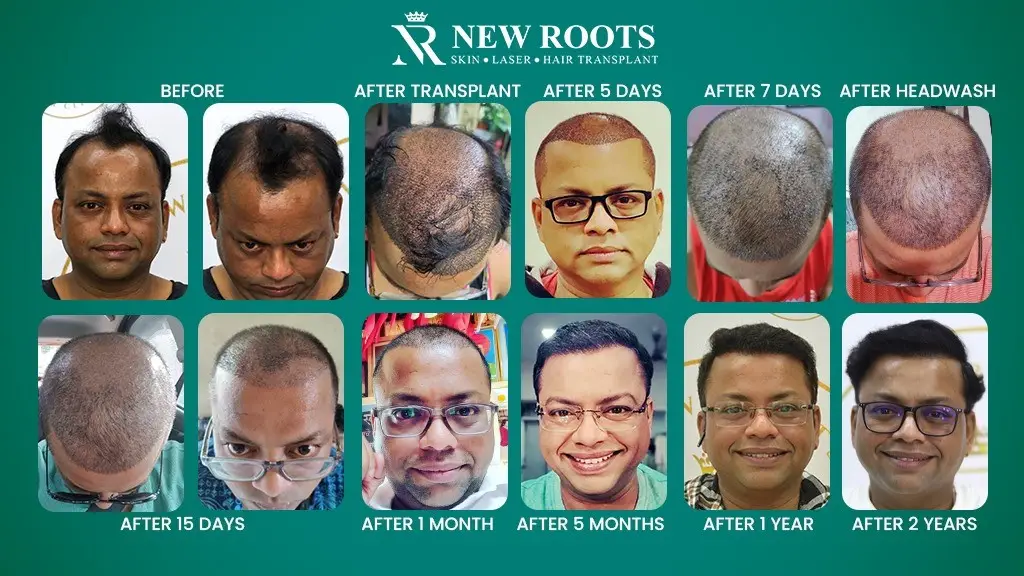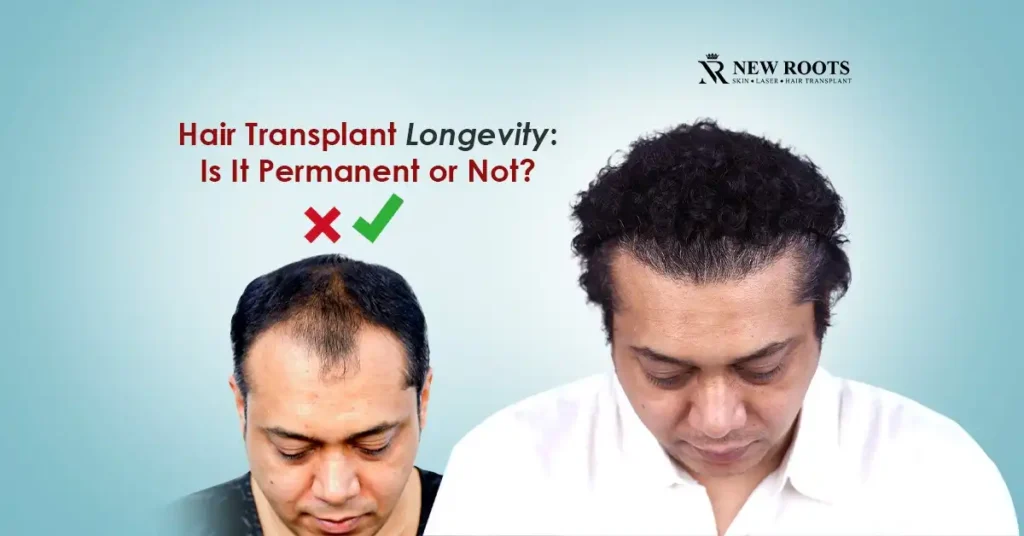Introduction
Baldness is a concern that prevails in the community among both male and female people of all ages. As for the given problem, one of the widely used treatments is hair transplantation.
However, a common question that arises is: Hair transplant is one of the most popular ways that men use to regain their self-esteem and cope with baldness issues; however, the question “Does hair transplant last forever” remains unclear.
Table of Contents
What is a Hair Transplant?
A hair Transplant is a surgical technique that removes skin containing healthy hair follicles from one part of the body, typically the scalp, and transplants it to a bald or balding area of the body, again; usually the scalp.
A hair transplant is a mode of hair restoration surgery by moving hair follicles from one region of the scalp, normally the back or sides of the head to the balding region.
This procedure is performed for place relaying a natural hairline or increasing hair density. Estrogenic alopecia is the main use of hair transplant surgery which is a genetic plan that causes hair loss.
How Hair Transplants Work
The process is initiated by a consultation, which involves an examination of the hair loss pattern and the patient’s aims and anticipated outcomes.
Following this, hair follicles are extracted using one of the two main techniques:
Follicular Unit Extraction (FUE) is also known as Follicular Unit Transplantation (FUT). The grafts receive their blood supply and start growing hair as if they are still in the original location of the follicles.
Types of Hair Transplantation?
Follicular Unit Extraction (FUE):
FUE entails taking one hair follicle at a time from the donor area with a round-cutting tool. This procedure is joined with decreased skin lesions and the time needed for healing.
Follicular Unit Transplantation (FUT):
FUT which is commonly known as strip harvesting involves the excision of a strip of the scalp with the hair follicles.
This method enables a large number of follicles to be transplanted in one session although the donor site is left with a scar that is linear and will take a longer time to heal.
Does Hair Transplant Last Forever?
The durability of this procedure often poses massive interest and questions. The assertion that “Does Hair Transplant Last Forever” hinges upon several key factors:
Genetics of Donor Follicles:
The hair that grows back on a bald head or the recipient area comes from the donor site and relies on the back and the sides of the head which are less likely to experience baldness due to conditions like androgenetic alopecia or male or female pattern baldness.
These areas are preordained by genetic endowment to involuntarily rebut the detrimental impact of dihydrotestosterone (DHT), a hormone lethal to hair. Thus, when relocated to the areas affected by baldness, these hardwearing follicles tend to remain undeterred in their behavior.
Establishment and Growth:
When hair follicles are grafted, they pass through a cycle Once the hair transplant is done, The hair follicles evolve through several phases.
In the beginning, the relocated hair is likely to fall out in a few weeks, a situation described as shock loss. The roots of the hair expand within the new site thereby growing new hair that is commonly permanent provided origin conditions exist.
Long-Term Outcomes:
Studies, case studies, and investigations have proved that hair that arises from the transplanted hair follicle can last a lifetime.
This depends on several crucial aspects which consist of the age of the patient, the rate at which the hair is falling, and the genetic background of the individual.
Thus, the patient must realize that although the transplanted hair will be permanent, the rest of the scalp may still undergo balding and create a disparity in the density ratio in the future.
The Role of Maintenance:
Although the follicles that are transplanted to the patient are likely to be permanent, there is the aspect of the health and look of the hair that may require continued treatment.
That is why patients might require other surgical interventions aimed at maintaining and further improving the result of the operation, as the hair thinning processes remain active even in the non-transplanted hair due to natural aging factors.
Factors Influencing the Longevity of Hair Transplants
Surgeon's Expertise:
The knowledge of the operative trivia of a medical doctor, specifically a plastic surgeon, is at the center of maintaining the results of hair transplant.
A good surgeon will ascertain that follicles are extracted in the right way and that they are implanted in the right manner so that they can increase their chances of survival.
Surgeon's Experience
Technical Skill and Precision:
An experienced surgeon, he has the needed skills that would enable him to do the operation in a very precise manner. The efficiency of the extraction and implantation process has to take into account the preservation of hair follicles so that they are still living when grafted.
Artistic Judgment:
Beyond exact knowledge and a mechanistic approach to surgery, clinicians’ experience can easily be equated to sensitivity to beauty. Several surgeons have the skills of providing good hairlines and making the transplanted hair match with the natural hair.
It can effectively be said that this aesthetic judgment is a positive factor in patient satisfaction and the entire success of the transplant.
Problem-Solving:
These experts in hair restoration have commonly seen all types of hair loss conditions and patient’s body structures. This puts them in a position of being able to work out individual treatment strategies for patients and cope with any adverse reactions successfully. In turning the graft survival rate to the optimum levels, flexibility is very crucial.
PostopeProtocolrative :
Expert doctors will not only operate on the client but will also oversee every stage of the healing process and recommend how to care for one’s body in the future. Choosing an excellent expert with excellent experience and past performance history can help determine the probabilities of sustaining the change processes.
Post-operative Care
Healing and Protecting the Scalp:
After the hair transplant, the condition of the scalp might be tender and require extra care. Sanitizing procedures that are adopted with instructions provided by the surgeon assist in avoiding infections and ensure that the small cuts made during the implantation of follicles heal.
Medication and Treatments:
Details like antibiotics to prevent infection, and anti-inflammatory drugs to reduce examination are administered to patients by Surgeons. Following these recommendations to the latter is important to allow the scalp to heal and for the follicles that have been transplanted to grow properly.
Avoiding Environmental Damage:
Recommendations on a patient's movements for the first days after the surgery include avoiding exposure to the sun and strenuous activities. Protecting the head with a hat is useful to aid in healing because it protects the scalp from contact with irritants found in the environment.
Understanding Hair Growth Cycles:
Teaching patients about the nature of hair growth after an operation is also considered some of the post-operative care information that needs to be passed on to the patient. It is normal for transplanted hair to fall off, and along with this shedding, new hair grows back.

Quality of the Donor Area
Genetic Factors:
The hair follicles in the donor area are by genetic code proven to be highly resistant to balding. They also said that areas that are healthy and genetically resistant to thinning can give strength to the supply required for transplantation.
Health of Follicles:
The extent of the hair transplant procedure depends on the rate of health and productivity of the follicles shaved. Such parameters include differences in thickness: healthy thick follicles are much better adapted to grow in the donor site than the thin and weak ones.
Density of Follicles:
More hair volume can be obtained from a densely populated follicular area when compared to a sparsely populated area. This means that with a rich supply, more grafts can be taken and this can result in him having a full head of hair.
Assessment of Donor Quality:
Before the transplant operation, it is highly important to evaluate and examine the donor area. Surgeons have to assess the density, and quality of the donor area’s follicles as well as their location for suitability for transplantation.
What to Expect After a Hair Transplant?
Initial Shedding and Shock Loss:
About three weeks after undergoing hair transplant surgery, patients may develop a condition called shock loss in which the hair transplanted falls off.
This is because the hair follicles get into the resting phase immediately after the transplantation process. It is fine and one should not freak out over it or worry themselves sick about it anymore.
New Hair Growth:
Once the hair has begun to fall out, hair regrowth most times begins several months after the surgery has been conducted. It is approximately three to four months after having the procedure done that patients may start experiencing hair regrowth albeit, thin and fragile hair. Eventually, this hair will fill in and get density.
Timeframe for Full Results:
This procedure is not like using a wig to cover the head hence the complete results of a hair transplant take time to be evident. The process of result formation may take from six months to one year, which the patient will see in full. This slow process enables the follicles to adapt and get acquainted with new conditions, and thus better hair growth is realized.
Can You Expect Your Transplanted Hair to Last a Lifetime?
Durability of Transplanted Hair:
About the question of whether or not a hair transplant lasts forever, it is necessary to note that most of the transplanted hair can be approved for long-term results.
The hair units applied are taken predominantly from zones of the scalp that are considered not to be affected by MPB and thus are likely to develop successfully.
Ongoing Natural Hair Loss:
Though one is likely to expect that the transferred hairs are going to remain there for some time, it is good to understand that not all hair still present on one’s head is immune to the normal hair-shedding process.
Nevertheless, it may be found that the hair in the non-transplanted zone continues to thin and gradually starts to fall out with time. This results in an uneven distribution of hair density; thus, the general hairline and density are affected.
Caring for Your Transplanted Hair
Washing Instructions:
Washing after the operation should be done according to the recommendations of doctors to preserve the life of transplanted follicles. Sometimes patients are advised on when to take a shower and avoid washing their hair thus interfering with the grafted hair.
Avoiding Strenuous Activities:
Taking exercise, for the initial weeks, is discouraged as it leads to perspiration and breathing difficulties common in patients. Sweating usually implies an issue with the body temperature regulation and this extra sweat can trigger the scalp and possibly harm the follicles that have been transplanted.
Sun Protection:
In general, direct sun exposure can be damaging to the fresh new grafts. The patients are often advised to avoid sun exposure on the scalp mainly during the initial one or two weeks after the procedure.
Use of Specialized Hair Care Products:
Hair care specialists are likely to advise their clients to use particular hair treatment commodities that are suitable for use when healing and encouraging hair regrowth among surgeons. Such specialized products usually include contents that do not harm the scalp and are useful in protecting the grafted hair.
The Importance of Ongoing Treatments
Support for Existing Hair Health:
Not that the hair transplant surgeries are not fruitful but the patients are advised to go for further treatments to maintain the residue hair. Topical minoxidil for example can promote hair growth in the areas that have scanty hair growth and it is often administered along with other treatments.
Medications Such as Finasteride:
Another drug commonly used to fight hair loss and sustain hair is finasteride. It functions in the manner of blocking the hormone DHT which plays an important role in causing hair loss. The use of such medications can minimize the extent of hair loss and increase the aesthetic quality of hair.
Enhancing Fullness:
Contact treatments do not only allow for sustaining the existing hair quality but can also address the issue of increasing the thickness of hair in general. Using such therapy choices, patients realize that they receive more even and thicker hair in the long run.
Summary of Long-Lasting Results
Role of Professional Expertise:
The chief surgery performed in a hair transplant is critical more often than not in the hands of the hair transplant surgeon. Such a professional who has sound training and has invented satisfactory procedures then he or she would be able to get positive results in the graft placement and, therefore, maximum survival of the follicles.
The expertise in this imaging is useful in the surgical aspect as well as in the aesthetic component: the hairline design and the distribution of Follicular units.
Importance of Post-operative Care:
If proper care is not taken in the aftermath of the transplantation the health and brightness of the transplanted hair is at risk.
Scalp hygiene and management during the period especially through the sun can have an impact on the success of the transplant depending on the surgeon’s recommendation.
Such care ensures that the follicles that have been implanted are healthy and anchored by the scalp to produce healthy hair.
Management of Ongoing Hair Loss:
However, it has to be noted that even when patients opt for hair transplantation, hair loss poses a latent possibility, especially in the areas of the scalp that have not been transplanted.
Proper control of this progressive condition is therefore vital in maintaining both the quantity and quality of hair in the best way possible. By using additional interventions, topical therapies, or medications, one can go a long way in preventing further hair loss or even retaining the hair that is already present on the head.
Answering the Question: Does Hair Transplant Last Forever?
Expectation of Longevity:
If evaluating “Does Hair Transplant Last Forever”, it is generally presupposed that the implanted follicles possess abilities to grow throughout a person’s lifetime.
This is just when the transferred hair is from the areas that are naturally immune to baldness for its lengthy sustenance. Hence, the other area of the patient’s body that experiences thinning of hair will not affect the growth of hair that has been transplanted.
Conditional Factors for Success:
However, most sources support the idea that the outcomes of transplantation are permanent but to maintain such outcomes, in the case of masculine baldness, the patient will need to adhere to the dictated course of action and address issues of further hair loss.
This position stresses a more individual-oriented approach for patients which means that a patient becomes fully responsible for hair’s condition as a part of their long-term plan.
Overall Satisfaction:
When hair transplants are carried out effectively, and the potential treatment of hair loss is begun alongside requisite precautions when it comes to after-care, many patients come out very satisfied. Such satisfaction is then enhanced by the appearance of the implanted hair besides the enhancement of their general look.
Conclusion
In conclusion, it can be stated that 99% of hair transplantation procedures, when conducted correctly by an experienced surgeon and also accompanied by proper treatment and care, can endorse the permanency of the intervention and the naturalness of the outcome.
Hence, when pondering over the question “Does hair transplant last forever” the answer is an absolute affirmative under the condition that the post-surgical treatment and the results of the hair loss are properly managed.
From a similar perspective, this extensive informative document is a perfect resource for basic information about hair transplant surgery and the issue of its permanency.
Whether one is planning to undergo the procedure or is just interested in the procedure and outcome, adequate consultation as well as analysis with qualified personnel that is present in New Roots Skin Hair Laser amount to voluntary choices in the process of hair loss treatment.
Q&A ASK :
Generally, such operations are made in a manner that intended hair transplants can serve people throughout their lifetime. Donor hairs are taken from areas of the scalp that show resistance to hair loss, therefore, hairs tend to grow; however, new hair loss may impact the hair’s density.
Most of the hair that has been transplanted is likely to remain strong and immune to the balding process for the next twenty years though qualities like thinning or graying may occur. Caring for the hair is also used to ensure that the transplanted hair is retained in good condition.
A hair transplant operation is commonly believed to be a permanent remedy against baldness since the hair follicles are taken from the resistant zones of the body. Nevertheless, it doesn’t guarantee future hair loss in the untreated area which can need further procedure to treat it.
The hair that has been transplanted may fall within the first few weeks after the surgery due to shock loss, this is however not expected to be permanent. The follicles normally reproduce new hair in the next months and therefore, make the hair appear thicker in the long run.
However, normally hair transplants are carried with low risk factors and are said to be safe when in the hands of expert surgeons. But sometimes there is a possibility of infection or scarring, which is why the patient should follow all the preoperative and postoperative regimes.





